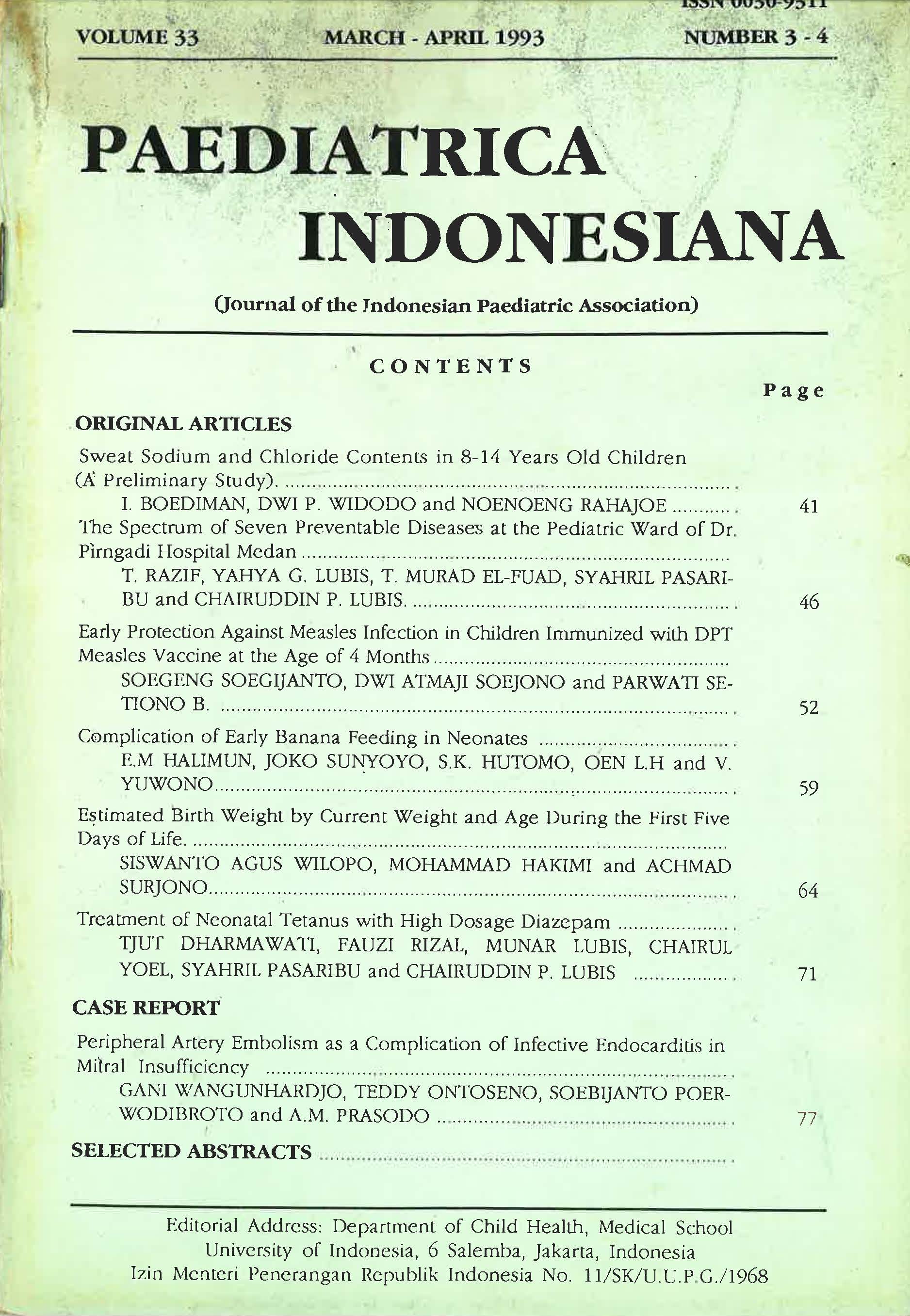Estimated Birth Weight by current Weight-and Age During the First Five Days of Life
Abstract
In the developing countries, measurement of birth weight is subjected to methodological problems. The main issue is the difficulty of measuring birth weight soon after delivery. Two relevant questions are proposed by this study : 1) can a birth weight be estimated several hours or days after a baby was delivered ?, and 2) can an estimated birth weight be collected by paramedical personnel with reliable results?
To answer these questions, we conducted a study at Dr. Sardjito Hospital, Yogyakana, to evaluate agreement between two paramedical personnel in the routine measurements of neonatal weight in the rooming-in ward. The behavior of these two paramedical personnel was observed from one month when they examined 32 neonates. Both of them weighed the neonate at 7.00 hours and one weighed the neonate at 15.00 or 21.00 hours. The order of the last two measurements was made alternatingly.
This resulted in 156 pairs of measurement for agreement analysis. There was a strong evidence that the two raters have almost perfect agreement on measuring neonatal weights (intraclass correlation coefficient = 0.978). The second part of this study looked at neonatal weight during the first five days of life. The neonatal weights were measured three times a day up to age of the days. We constructed a formula for estimating their birth weight based on a current neonatal weight and age in days. Birth weight can be estimated using formula : Birth weight ; 51 + 1. 029 x current weight - 10 x age in days. The data fitted very well to this least square estimate with a coefficient of determination (R) = 0.95.
References
2. World Health Organization. The incidence of low birth weight : an update. Weekly Epid Rec 1984; 59 ; 205- 12.
3. Alisyahbana A, Sukadi A, Hamzah ES, et al. Perinatal mortality and morbidity survey and low birth weight, final report V. Bandung : Fakultas Kedokteran Universitas Padjajaran, 1983.
4. Surjono A. Neonatal mortality in Yogyakarta rural areas Pediatr lndones 1988 : 97 - I 04.
5. Prihartono ], Budiarso RL. Kematian perinatal di pedesaan Sukabumi. Kumpulan naskah lengkap Lokakarya ASI & Seminar Perinatologi. Jakarta, 1984; 49 - 56.
6. Alisyahbana A, Peeters R, Meheus A. Traditional birth attendants can identify mothers and infants at rixk. World Health Forum 1986; 7: 240- 2.
7. Kramer MS, Feinstein AR. Clinical biostatistics LIV. the biostatistics of concordance. Clin Pharm Ther 1981; 29(1): 111-23.
8. Fleiss JL. Statistical methods for rates and proportion; 2ndl ed. New York: Wiley, 1981.
9. SAS. SAS/STAT guide for personal computer; version 6 edition. North Carolina: SAS Institute Inc., 1986.
10. Kumar VK, Walia I. Recording of birth weight range by traditional birth attendants (dais) in village northern India. J Trop Pediatr 1986; 32: 66-8.
Copyright (c) 2018 Siswanto Agus Wilopo, Mohammad Hakimi, Achmad Surjono

This work is licensed under a Creative Commons Attribution-NonCommercial-ShareAlike 4.0 International License.
Authors who publish with this journal agree to the following terms:
Authors retain copyright and grant the journal right of first publication with the work simultaneously licensed under a Creative Commons Attribution License that allows others to share the work with an acknowledgement of the work's authorship and initial publication in this journal.
Authors are able to enter into separate, additional contractual arrangements for the non-exclusive distribution of the journal's published version of the work (e.g., post it to an institutional repository or publish it in a book), with an acknowledgement of its initial publication in this journal.
Published 2018-12-12













